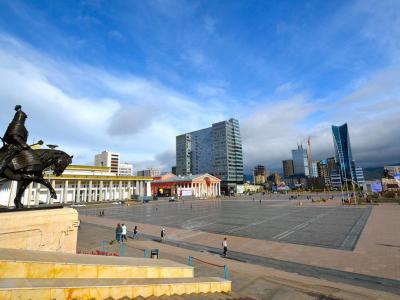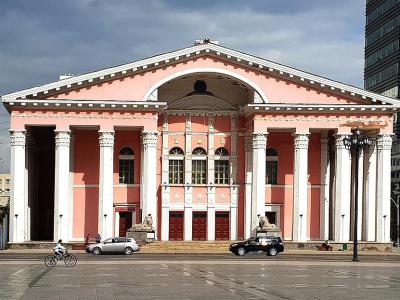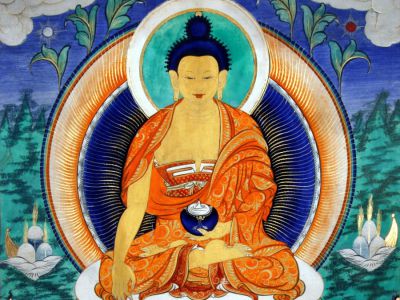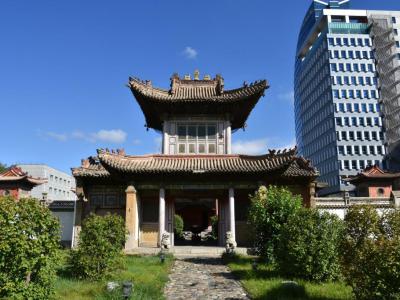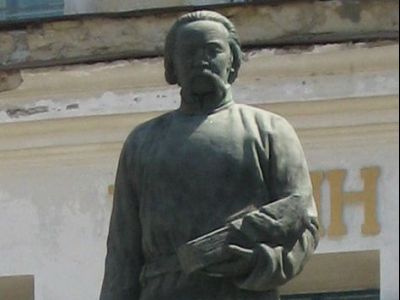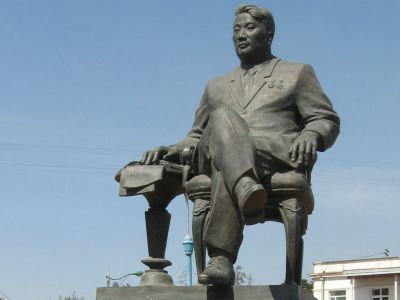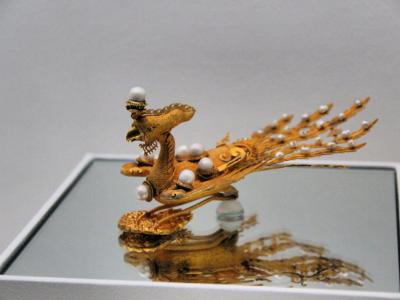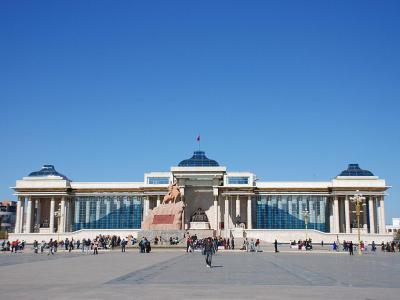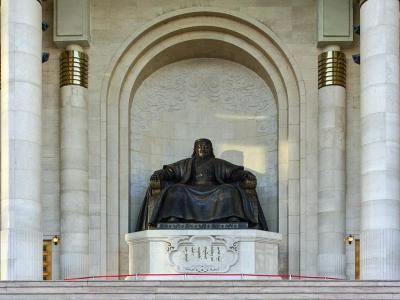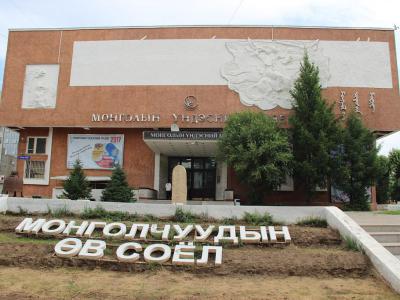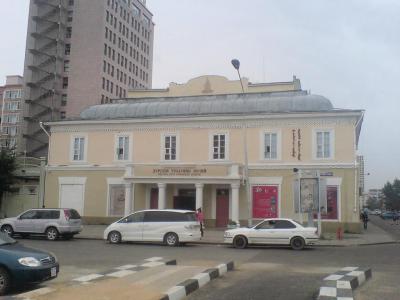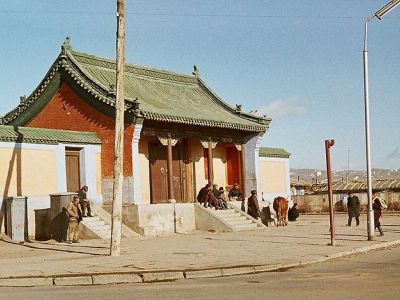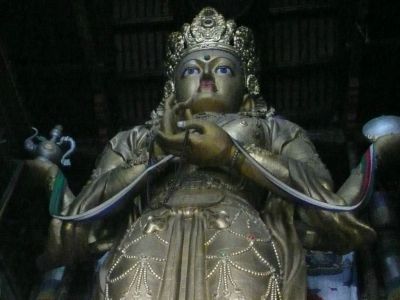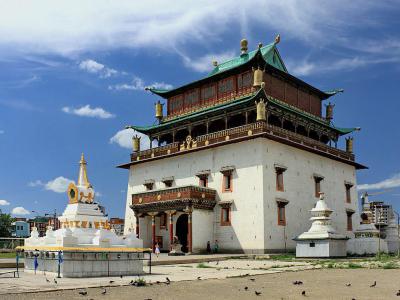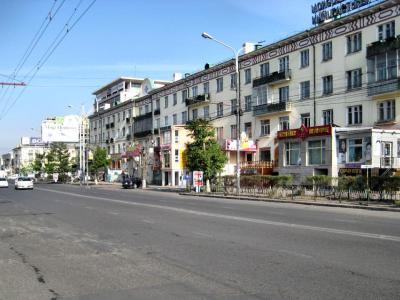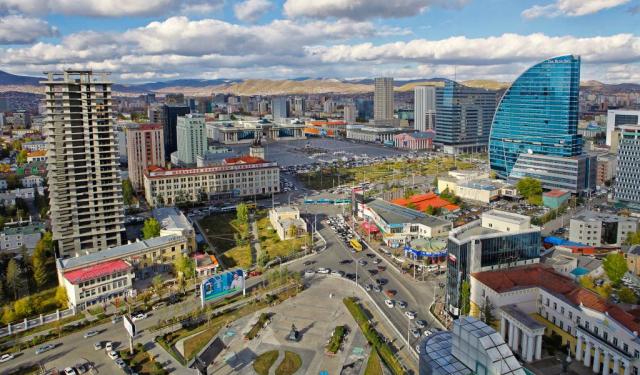
Ulan Bator Introduction Walking Tour (Self Guided), Ulan Bator
Ulan Bator is Mongolia’s cultural, political, economic and social center. The downtown part of the city abounds in prominent attractions: government buildings, famous landmarks, quality museums and more. Follow this orientation walk to discover the most interesting sights of Ulan Bator.
How it works: Download the app "GPSmyCity: Walks in 1K+ Cities" from Apple App Store or Google Play Store to your mobile phone or tablet. The app turns your mobile device into a personal tour guide and its built-in GPS navigation functions guide you from one tour stop to next. The app works offline, so no data plan is needed when traveling abroad.
Ulan Bator Introduction Walking Tour Map
Guide Name: Ulan Bator Introduction Walking Tour
Guide Location: Mongolia » Ulan Bator (See other walking tours in Ulan Bator)
Guide Type: Self-guided Walking Tour (Sightseeing)
# of Attractions: 15
Tour Duration: 3 Hour(s)
Travel Distance: 5.3 Km or 3.3 Miles
Author: leticia
Sight(s) Featured in This Guide:
Guide Location: Mongolia » Ulan Bator (See other walking tours in Ulan Bator)
Guide Type: Self-guided Walking Tour (Sightseeing)
# of Attractions: 15
Tour Duration: 3 Hour(s)
Travel Distance: 5.3 Km or 3.3 Miles
Author: leticia
Sight(s) Featured in This Guide:
- Sükhbaatar Square
- The National Academic Theatre of Opera and Ballet of Mongolia
- Mongolian National Modern Art Gallery
- Choijin Lama Museum
- Yünsiyebü Byambyn Rinchen Monument
- Marshal Yumzhagiyn Tsedenbal Monument
- Mongolian Artists' Exhibition Hall
- Parliament Building
- Genghis Khan Monument
- National Museum of Mongolia
- Zanabazar Museum of Fine Art
- Geser Sum Monastery
- Tasgany Ovoo
- Gandan Monastery
- Peace Avenue
1) Sükhbaatar Square (must see)
Sükhbaatar Square is the central square in Ulan Bator. It is named after and features a statue of Damdin Sükhbaatar, leader of Mongolia's 1921 revolution. It is located in front of the Saaral Ordon. Major buildings on the square include the Government Palace (built in 1951), the Golomt Bank, the Central Post Office, the Culture Palace and, until 2005, the Sükhbaatar mausoleum. Besides the Sükhbaatar monument in the middle of the square, one can find several other statues, including Genghis Khan and two of his generals in front of the Government House and the Jamsrangiin Sambuu monument in the northwestern corner.
Sight description based on Wikipedia.
2) The National Academic Theatre of Opera and Ballet of Mongolia
The National Academic Theatre of Opera and Ballet of Mongolia (colloquially called Ulaanbaatar Opera House) opened on 15 May 1963 and made its opening ceremony on 18 May 1963 with Tchaikovsky’s Eugene Onegin.
The repertoire includes classical and national ballet (Swan Lake, The Nutcracker) and opera (Madama Butterfly, La bohème).
The beginnings of a contemporary professional theatre in Mongolia were laid down with the establishment of a National Central Theatre in 1931, which was an extension of the Folk Stadium which was inaugurated in 1927.
The repertoire includes classical and national ballet (Swan Lake, The Nutcracker) and opera (Madama Butterfly, La bohème).
The beginnings of a contemporary professional theatre in Mongolia were laid down with the establishment of a National Central Theatre in 1931, which was an extension of the Folk Stadium which was inaugurated in 1927.
Sight description based on Wikipedia.
3) Mongolian National Modern Art Gallery (must see)
The Mongolian National Modern Art Gallery (MNMAG) features a wide and remarkable collection of modern and uniquely Mongolian paintings and sculptures. You will enjoy a variety artwork, ranging from impressionistic to nationalistic, interesting Soviet romantic paintings and other wonderful works.
4) Choijin Lama Museum (must see)
The Choijin Lama Museum is a Mongolian architectural masterpiece of the 19th century. It features precious exhibits of Buddhist art as well as the works of Zanabazar, a prominent 17th century spiritual head of Tibetan Buddhism and great artisan. You will find beautiful colorful masks for Tsam dance ceremonies, wonderful bronze figures of gods, striking silk tankas and many other interesting objects.
5) Yünsiyebü Byambyn Rinchen Monument
In front of the National Library of Mongolia in Ulan Bator is the monument to Yünsiyebü Byambyn Rinchen, one of the founders of modern Mongolian literature, a prominent translator and diverse scientist.
6) Marshal Yumzhagiyn Tsedenbal Monument
This monument commemorates Yumzhagiyn Tsedenbal, politician, first secretary of the Mongolian People’s Revolutionary Party, chairman of the People’s Republic of Mongolia, and marshal, who governed Mongolia for 40 years. The monument is located in front of the Theatre for Dramatic Arts.
7) Mongolian Artists' Exhibition Hall
Located on the corner of Peace Avenue and Chingisiin Örgön Chölöö, the Mongolian Artists' Exhibition Hall offers an interesting view of Mongolian art. Its collection of contemporary art features dramatic pictures, amazing carvings, beautiful tapestries and sculptures.
8) Parliament Building
A very large, wonderfully decorated and very colorful building. It is located on the north side of Sükhbaatar Square, along with a lot of other important buildings in the city. The edifice is an excellent example of a great tandem between the ancient and modern architecture.
9) Genghis Khan Monument (must see)
In front of the Mongolian Government Palace, in the prominent Sükhbaatar Square, is the statue of Genghis Khan, the national hero, founder, Khan (ruler) and Khagan (emperor) of the prosperous Mongol Empire.
10) National Museum of Mongolia (must see)
National Museum of Mongolia (formerly the National Museum of Mongolian History) is one of the national museums of Mongolia. The National Museum of Mongolia is a cultural, scientific, and educational organization, which is responsible for the collection, care and interpretation of the objects.
The first museum in Mongolia, which was called the Mongolian National Museum (now the Mongolian Natural History Museum), was established in 1924 and became the basis for other museums, including the National Museum of Mongolian History.
The modern National Museum of Mongolian History was established after the merger of historical, archeological and ethnographical departments of the State Central Museum and the Museum of the Revolution in 1991. It is now located in the facility built for the Museum of the Revolution, which was founded in 1971. The National Museum of Mongolia is currently recognized as one of the leading museums in Mongolia. A significant responsibility for preserving Mongolian cultural heritage therefore lies with the museum. It is also responsible for developing museological guide-lines for museums in the nation.
The first museum in Mongolia, which was called the Mongolian National Museum (now the Mongolian Natural History Museum), was established in 1924 and became the basis for other museums, including the National Museum of Mongolian History.
The modern National Museum of Mongolian History was established after the merger of historical, archeological and ethnographical departments of the State Central Museum and the Museum of the Revolution in 1991. It is now located in the facility built for the Museum of the Revolution, which was founded in 1971. The National Museum of Mongolia is currently recognized as one of the leading museums in Mongolia. A significant responsibility for preserving Mongolian cultural heritage therefore lies with the museum. It is also responsible for developing museological guide-lines for museums in the nation.
Sight description based on Wikipedia.
11) Zanabazar Museum of Fine Art (must see)
The Zanabazar Museum of Fine Art, established in 1966, houses a great collection of excellent works by famous sculptor and artist Zanabazar. The museum also features exceptional works by other well-known Mongolian artists of the 19th and 20th centuries, including wood and stone appliqués and sculptures, an outstanding collection of paintings, carvings, old religious exhibits and much more.
12) Geser Sum Monastery (must see)
Geser Sum Monastery, also known as West Geser Sum, was built between 1919 and 1920 by Guve Zakhar, a practitioner of the Blue religion (Chinese Taoist Buddhism). Located in the central district of Ulan Bator, on the south side of the hill with Dasgan Ovoo, this cultural and historic monument now houses a Buddhist school.
13) Tasgany Ovoo
Tasgany Ovoo is located 300 meters behind the fine Geser Sum and is certainly worth a visit. This ovoo is a sacred pyramid-shaped collection of stones. On the top of the hill you will notice a 12 meter-high Buddhist monument, the famous Zaany Tolgoi, or Elephant's Head.
14) Gandan Monastery (must see)
The Gandantegchinlen Monastery (short name: Gandan), a Tibetan monastery in the Mongolian capital of Ulan Bator, has been restored and revitalized since 1990. It was established in 1835 by the Fifth Jebtsundamba, Mongolia's highest reincarnated lama at the time. The name translates as "Great Place of Complete Joy." It currently has over 150 monks in residence. It features a 26.5 meter-high statue of Migjid Janraisig, a Buddhist bodhisattva also known as Avalokitesvara. This monastery became the principal center of Buddhist learning in Mongolia.
Sight description based on Wikipedia.
15) Peace Avenue
Peace Avenue is the main shopping street in the city. Is the place to haggle over cheap clothes, toys, swords or Soviet propaganda pins.
Sight description based on Wikipedia.
Walking Tours in Ulan Bator, Mongolia
Create Your Own Walk in Ulan Bator
Creating your own self-guided walk in Ulan Bator is easy and fun. Choose the city attractions that you want to see and a walk route map will be created just for you. You can even set your hotel as the start point of the walk.
City Center Monuments
Ulan Bator has a rich and mysterious history. It is home to many historic landmarks and prominent monuments. Among them are the celebrated Genghis Khan Monument, Lenin Monument, Beatles Monument and many others. Take the following tour to visit the famous monuments of Ulan Bator city Center !
Tour Duration: 2 Hour(s)
Travel Distance: 3.4 Km or 2.1 Miles
Tour Duration: 2 Hour(s)
Travel Distance: 3.4 Km or 2.1 Miles
The Most Popular Cities
/ view all
